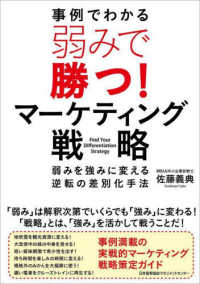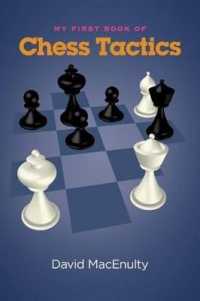- ホーム
- > 洋書
- > 英文書
- > History / World
Full Description
Chinese culture, to readers of English, is somewhat veiled in mystery. Fundamentals of Chinese Culture, a classic of great insight and profundity by noted Chinese thinker, educator and social reformist Liang Shuming, takes readers on an intellectual journey into the five-thousand-year-old culture of China, the world's oldest continuous civilization. With a set of Chinese-style cultural theories, the book well serves as a platform for Westerners' better understanding of the distinctive worldview of the Chinese people, who value family life and social stability, and for further mutual understanding and greater mutual consolidation among humanities scholars in different contexts, dismantling common misconceptions about China and bridging the gap between Chinese culture and Western culture. As a translation of Liang Shuming's original text, this book pulls back the curtain to reveal to Westerners a highly complex and nuanced picture of a fascinating people.
Contents
About Liang Shuming and The Fundamentals of Chinese Culture, Acknowledgements, Profile of the Translator, Contents, Preface to this Translation, Liang's Preface, Chapter One Introduction, 1.1 Definition of Chinese Culture, 1.2 Specifics of Chinese Culture, 1.3 Features of Chinese Culture, 1.4 Referential and Supporting Evidence, Chapter Two Family to Chinese People, 2.1 Fung Yu-lan's Interpretation, 2.2 Partiality of Fung's Interpretation, 2.3 Formation of Culture and its Characteristics, 2.4 A Ladder-like Progress View versus a School-based View, 2.5 Additional Remarks, Chapter Three Westerners Living as a Group, 3.1 Contrasting Chinese Society and Western Society, 3.2 Divide between Chinese Culture and Western Culture, 3.3 Christianity and Group-centered Life, 3.4 Medieval Society in Europe, 3.5 The Seeds of Modern Society, Chapter Four Chinese People's Lack of Group-centered Life, 4.1 Westerners' Merits and Our Demerits, 4.2 Chinese People's Lack of Group-centered Life, 4.3 Incompatibility between Group-centered Life and Family Life, Chapter Five China as an Ethics-Oriented Society, 5.1 Definition of Ethics-Orientedness, 5.2 Ethics in Economic Life, 5.3 Ethics in Political Life, 5.4 Ethics as a Religion, 5.5 The Ultimate Outcome, Chapter Six Morality as Religion, 6.1 Definition of Religion, 6.2 Religion in China, 6.3 Non-Religious Nature of the Moral Cultivation of the Duke of Zhou and Confucius, 6.4 Morality in Place of Religion in China, 6.5 Rites of the Duke of Zhou and Confucius, 6.6 Organizing Society through Morality, Chapter Seven Rationality - A Human Characteristic, 7.1 Definition of Rationality, 7.2 Two Inclinations and Two Misconceptions, 7.3 Chinese People's National Spirit, Chapter Eight Class Divisions and Professional Distinction, 8.1 Definition of Class, 8.2 Are There Classes in China?, 8.3 Definition of Professional Distinction, Chapter Nine China: A Nation or Not?, 9.1 China: Unlike a Nation, 9.2 A Nation Derived from Class Rule, 9.3 The Collapse of Feudalism in China, 9.4 Uniqueness of China's Politics, 9.5 Reasons for the Progress of Western Politics, Chapter Ten Governance and Times of Peace and Prosperity, 10.1 Chinese Social Structure, 10.2 A Life of Inner Discipline, 10.3 Splendor in Chinese Civilization, 10.4 The Function of Scholars in Chinese Civilization, 10.5 Governance versus Times of Peace and Prosperity, Chapter Eleven A Cycle of Times of Peace and Prosperity and Periods of Chaos, 11.1 Recurring Periods of Chaos in China, 11.2 Lack of Revolutions in China, 11.3 Absence of an Industrial Revolution in China, Chapter Twelve Human Cultural Precocity, 12.1 Lack of Democracy in China, 12.2 Lack of Human Rights and Freedom in China, 12.3 Lack of Government by the People, 12.4 Human Cultural Precocity, Chapter Thirteen China after Cultural Precocity, 13.1 Lack of Science as a Result of Cultural Precocity, 13.2 Good at Rationality but Bad at Reason, 13.3 Stagnation of Progress in China, 13.4 Five Maladies in Chinese Culture, Chapter Fourteen Conclusion, 14.1 Summary of Previously Discussed Characteristics, 14.2 Shaping of National Character, Select Bibliography, Index








